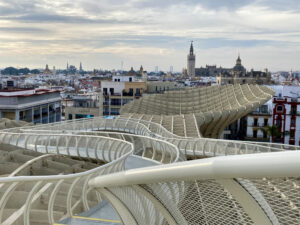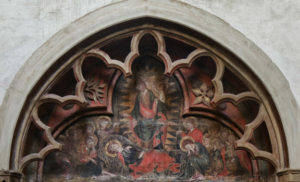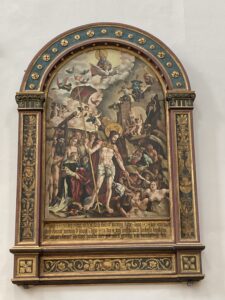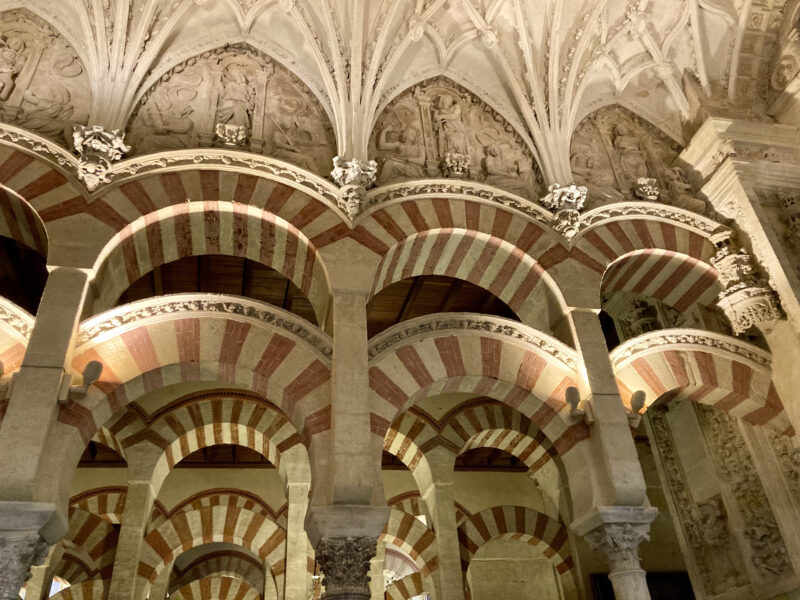My Regensburg Year Part 6: January 2025
At the end of last month’s account of our post-Christmas vacation in Portugal, we were about to board a bus to Seville on New Year’s Day. After our previous two attempts to book transport were cancelled, we were not optimistic that we would be able to get out of Portugal, but we were pleasantly surprised to find the bus waiting for us. Alas, that pleasantness soon dissipated once we met our driver. He barked at all of the passengers, including two young women who were confused about where to stow their luggage and me when I asked about the bathroom (“Sem banheiro!”). With an eight-hour journey ahead of us, my bladder immediately started sending out anxiety signals. Fortunately, we did stop for lunch. Afterward, the driver yelled at my wife and I for eating on board (it wasn’t clear whether he wanted the food off the bus or us). But all of this aggravation was put in the past once we arrived in Seville. Coming into a new town in darkness is not ideal—it’s difficult to get oriented and we didn’t even know if any restaurants would be open. Fortunately, we found a tapas bar and discovered the low cost of alcohol in Spain (less than 30 Euro for dinner and three glasses of wine!). I was in love. We finished the night with a walk around town and enjoyed the bright Christmas lights still hanging in the streets.

Over the next few days we hit a few of the main tourist attractions, including the Metropol Parasol (a wooden observation structure that looks kinda like a mushroom), the cathedral (with its enormous altarpiece—the largest in the world—featuring scenes from the life of Jesus), and the palace (for an amazing light and sound show in the gardens). We also came upon the preparation for the Three Kings’ Day parade. The floats were very elaborate (no string of lights on a pickup truck here) but one aspect of it was a bit disturbing (from a North American’s perspective): the line of mounted kings wearing black face. It was much later in the day when we saw the parade make its way around to the area of our hotel; by that point it looked like they were trying to finish off all the give-away candy by lobbing it at the crowd. The streets were quite sticky the next morning.
From Seville we took a day trip to Cordoba, principally to see the Mosque-Cathedral. The building began as a mosque in 785 and was expanded over the next few centuries before becoming a cathedral in 1236. It still has both Christian and Islamic architectural features. The cathedral is dedicated to Our Lady of the Assumption, but alas, I could find no relevant iconography there. While in Cordoba we also visited the town’s Jewish quarter with its well-preserved fourteenth-century synagogue. Nearby we got our first look at the city’s free-ranging feral cats who are fed and cared for by the city.

The rest of the month was taken up by a few small trips: Abensberg (location of a museum dedicated to architect and artist Friedensreich Hundertwasser), Amberg, Augsberg (the cathedral has a wide range of images from Marian apocrypha: the south tympanum of the includes scenes from the Protevangelium of James, an altarpiece depicts Mary and her mother Anna holding onto the infant Jesus, another altarpiece has a life of Mary cycle, and more images from the life of Mary appear in the north tympanum), and Erfurt. Of them all, Erfurt was most interesting as it was dotted with medieval churches dating from as early as the twelfth century. Unfortunately, many of them were not open, as they are no longer in use or have been repurposed for conference centres or columbaria (storage centres for cremated remains). The cathedral, dedicated to the Virgin Mary, was accessible and I was happy to find within it several works of art with scenes from Mary’s life and an altarpiece with a depiction of Jesus’ descent to hell. Also of interest was the Predigerkirche which is decorated with a fourteenth-century fresco depicting the death of Mary. One of the highlights of the weekend was a tour of the “Old Synagogue” which was built in the 1100s but repurposed after the pogrom of 1345 into a storage building and dance hall. Only in 1998 had the process begun to turn it into a museum site. The synagogue also had on display some facsimiles of the city’s Hebrew manuscripts and a horde of treasure discovered nearby, likely hidden by a wealthy Jewish family hoping to keep their valuables safe during turbulent times for the community.
On my work time this month I began planning for the SBL 2025 Annual Meeting. As the newly-minted chair of the Christian Apocrypha Section, I crafted a call for papers that includes sessions covering two recent interests of mine. For several years now the committee has toyed with the idea of mounting a session that would lead to a publication. To that end, we decided to assemble a group of scholars to translate the apocryphal hypomnemata of Symeon Metaphrastes. These texts draw upon earlier apocryphal texts but have attracted little attention from scholars—so far only one of them has been translated into English (Acts of Cornelius, translated by me for MNTA 1). At the time of writing almost all of the texts have been assigned and the first session in 2025 will feature an introduction by Christian Høgel (author of Symeon Metaphrastes: Rewriting and Canonization; Copenhagen: Museum Tusculanum Press, 2002) and the first round of presentations of the texts from our collaborators. This will be followed by a workshop in Regensburg in the summer of 2026 and then a second SBL session later that year. Fingers crossed, the publication should appear in 2027. We have a second session in partnership with the Religious World of Late Antiquity Section, focusing on the development of local cult in late antiquity. The final two sessions are open sessions but we are encouraging proposals dealing with paratexts. I was introduced to this topic when I took part (virtually) in a conference led by Garrick Allen at the University of Glasgow. Garrick and his team visited Regensburg in October and he invited me to come to Glasgow in March and present on a topic of my choice—I thought: how about paratexts in Greek manuscripts of the Infancy Gospel of Thomas? If we get enough proposals, perhaps we can entice Garrick to fly over to Boston and deliver a response.

For my AYBRL project, I turned from my chapter on infancy gospels to Passion gospels. The chapter mostly covers texts from the so-called Pilate Cycle, which includes the Acts of Pilate (aka Gospel of Nicodemus) and a number of sequels, usually taking the form of epistles. Many scholars and interested readers have some knowledge of a few of these texts but much of the detailed scholarship has not been reflected well in the English apocrypha compendia. For example, the Acts of Pilate is usually presented with the full text of the Greek A recension and then the second half of the Greek B recension, covering Christ’s descent to hell. The first half of Greek B is routinely neglected despite the fact that it includes some really interesting departures from the Greek A text (including several laments uttered by the Virgin Mary and Mary Magdalene and a lengthy scene of Joseph and Nicodemus burying Jesus). Some of the comments by scholars on the sequels to Acts of Pilate can be confusing. For example, the Report of Pilate (aka Anaphora Pilati) is extant in two forms: Greek A which circulates with a “response” and Greek B which circulates with another text called the Handing Over of Pilate (Paradosis Pilati). What gets obscured is that the “response” is actually a separate text that goes by the title Epistle of Tiberius to Pilate. Also of interest about these texts (Acts Pil. GrkB and Ep. Tib. Pil.) is that they allude to a meeting between Mary Magdalene and Tiberius about Pilate’s execution of Jesus that is mentioned also in the Life of Mary Magdalene (translated by Christine Luckritz Marquis in MNTA 2)—connections that were not adequately explored in MNTA. Another text from the Pilate Cycle that is often neglected is the Dream of Nero, a sequel that is found appended to some manuscripts of the Latin A version of the Gospel of Nicodemus. This text has never been translated into a modern language but can be read in summary on e-Clavis. The Passion gospels chapter will take some time to complete as I find myself having to spend time on other texts that have yet to appear in English, including several martyrdoms of Longinus and lives of Pilate. And I told my editor I’d be finished by Christmas! At this rate I’ll be lucky to be done before I leave Regensburg.

